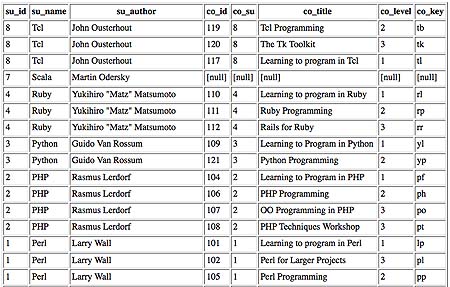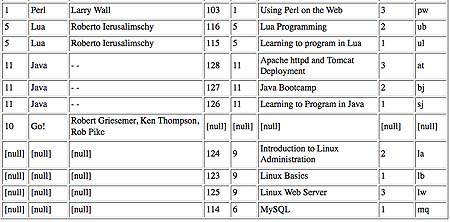
|
Training, Open Source Programming Languages |
| Home | Accessibility | Courses | The Mouth | Resources | Site Map | About Us | Contact |
| For 2023 (and 2024 ...) - we are now fully retired from IT training. We have made many, many friends over 25 years of teaching about Python, Tcl, Perl, PHP, Lua, Java, C and C++ - and MySQL, Linux and Solaris/SunOS too. Our training notes are now very much out of date, but due to upward compatability most of our examples remain operational and even relevant ad you are welcome to make us if them "as seen" and at your own risk. Lisa and I (Graham) now live in what was our training centre in Melksham - happy to meet with former delegates here - but do check ahead before coming round. We are far from inactive - rather, enjoying the times that we are retired but still healthy enough in mind and body to be active! I am also active in many other area and still look after a lot of web sites - you can find an index ((here)) |
|
Relating tables with joins in MySQL
Relational Databases are stores of data in which that data can be matched using common characteristics. For example, I have a table of data about programming languages (which includes a columns for the name of the language and the author) and another table of data about our courses which includes the course name, and the level - beginner, intermediate or advanced. With a relational database, one of the ways I can link the tables (relate the data in them together) is via a join.
When you are joining tables, you tell MySQL which column in the first table is to link to which column in the second table. And you also need to decide what to do about partial records that don't match up - do you ignore them, or fill them in with nulls to make the record complete? We have a very popular tutorial [here] on this. If you are looking for a combined table for presentation which includes unmatched ("orpan") records in both directions at the same time, you'll not be able to produce it with a single select - but rather you'll use a UNION of two selects, which you can combine into a single SQL statement. Here is an example: (select * from dm_subjects left join dm_courses The first join selects all the records that match across the tables and the records which are orphans in the left table. The second join adds in all the records which are built from orphans in the right table. In my example, I can now produce a combined result which shows on a single display ALL of my courses, ALL of the languages, whether of not there is a language description for the course, and whether or not we offer a course in the language. Let's see that table:   You'll note numerous complete records ... and also records for the Go! and Scala programming languages on which (at the time of writing) we don't offer courses. And you'll see records for our Linux and MySQL courses, even though those are not really programming languages to don't have the extra data from the language table.
The complete set of MySQL instructions that I used to set up this examples may be seen [here] (also includes sample joins!) and the PHP program / page which I used to present the data on the user's browser is [here]. You can run the join demonstration for yourself on our server [here] ... and of course we would welcome you on our MySQL Course here. (written 2010-02-21, updated 2010-03-03) Associated topics are indexed as below, or enter http://melksh.am/nnnn for individual articles S157 - More MySQL commands[158] MySQL - LEFT JOIN and RIGHT JOIN, INNER JOIN and OUTER JOIN - (2004-12-20) [159] MySQL - Optimising Selects - (2004-12-21) [279] Getting a list of unique values from a MySQL column - (2005-04-14) [449] Matching in MySQL - (2005-09-24) [494] MySQL - a score of things to remember - (2005-11-12) [502] SELECT in MySQL - choosing the rows you want - (2005-11-22) [513] MySQL - JOIN or WHERE to link tables correctly? - (2005-12-01) [515] MySQL - an FAQ - (2005-12-03) [517] An occasional chance, and reducing data to manageable levels - (2005-12-04) [567] Combining similar rows from a MySQL database select - (2006-01-17) [572] Giving the researcher power over database analysis - (2006-01-22) [581] Saving a MySQL query results to your local disc for Excel - (2006-01-29) [591] Key facts - SQL and MySQL - (2006-02-04) [673] Helicopter views and tartans - (2006-04-06) [1213] MySQL - the order of clauses and the order of actions - (2007-06-01) [1235] Outputting numbers as words - MySQL with Perl or PHP - (2007-06-17) [1331] MySQL joins revisited - (2007-09-03) [1574] Joining MySQL tables revisited - finding nonmatching records, etc - (2008-03-15) [1735] Finding words and work boundaries (MySQL, Perl, PHP) - (2008-08-03) [1904] Ruby, Perl, Linux, MySQL - some training notes - (2008-11-23) [2110] MySQL - looking for records in one table that do NOT correspond to records in another table - (2009-03-31) [2259] Grouping rows for a summary report - MySQL and PHP - (2009-06-27) [2448] MySQL - efficiency and other topics - (2009-10-10) [2644] Counting rows in joined MySQL tables - (2010-02-22) [2645] Optimising and caching your MySQL enquiries - (2010-02-22) [2647] Removing duplicates from a MySQL table - (2010-02-22) [3061] Databases - why data is split into separate tables, and how to join them - (2010-11-20) [3270] SQL - Data v Metadata, and the various stages of data selection - (2011-04-29) [4481] Extracting data from backups to restore selected rows from MySQL tables - (2015-05-01)
Some other Articles
Compile but do not run PHP - syntax check onlyRelating tables with joins in MySQL What does a web application look like under Tomcat? Object Oriented Programming in PHP How is your tax pound spent? su or su - ... what is the difference? Finding what has changed - Linux / Unix |
4759 posts, page by page
Link to page ... 1, 2, 3, 4, 5, 6, 7, 8, 9, 10, 11, 12, 13, 14, 15, 16, 17, 18, 19, 20, 21, 22, 23, 24, 25, 26, 27, 28, 29, 30, 31, 32, 33, 34, 35, 36, 37, 38, 39, 40, 41, 42, 43, 44, 45, 46, 47, 48, 49, 50, 51, 52, 53, 54, 55, 56, 57, 58, 59, 60, 61, 62, 63, 64, 65, 66, 67, 68, 69, 70, 71, 72, 73, 74, 75, 76, 77, 78, 79, 80, 81, 82, 83, 84, 85, 86, 87, 88, 89, 90, 91, 92, 93, 94, 95, 96 at 50 posts per pageThis is a page archived from The Horse's Mouth at http://www.wellho.net/horse/ - the diary and writings of Graham Ellis. Every attempt was made to provide current information at the time the page was written, but things do move forward in our business - new software releases, price changes, new techniques. Please check back via our main site for current courses, prices, versions, etc - any mention of a price in "The Horse's Mouth" cannot be taken as an offer to supply at that price.
Link to Ezine home page (for reading).
Link to Blogging home page (to add comments).
PH: 01144 1225 708225 • EMAIL: info@wellho.net • WEB: http://www.wellho.net • SKYPE: wellho
PAGE: http://www.wellho.net/mouth/2643_Rel ... MySQL.html • PAGE BUILT: Sun Oct 11 16:07:41 2020 • BUILD SYSTEM: JelliaJamb